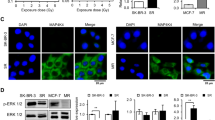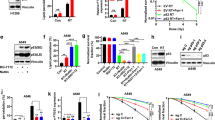Abstract
Radioresistance markedly impairs the efficacy of tumor radiotherapy and may involve antiapoptotic signal transduction pathways that prevent radiation-induced cell death. A common cellular response to genotoxic stress induced by radiation is the activation of the nuclear factor kappa B (NF-κB). NF-κB activation in turn can lead to an inhibition of radiation-induced apoptotic cell death. Thus, inhibition of NF-κB activation is commonly regarded as an important strategy to abolish radioresistance. Among other compounds, the fungal metabolite gliotoxin (GT) has been reported to be a highly selective inhibitor of NF-κB activation. Indeed, low doses of GT were sufficient to significantly enhance radiation-induced apoptosis in HL-60 cells. However, this effect turned out to be largely independent of NF-κB activation since radiation of HL-60 cells with clinically relevant doses of radiation induced only a marginal increase in NF-κB activity, and selective inhibition of NF-κB by SN50 did not result in a marked enhancement of GT-induced apoptosis. GT induced activation of JNKs, cytochrome c release from the mitochondria and potently stimulated the caspase cascade inducing cleavage of caspases −9, −8, −7 and −3. Furthermore, cleavage of the antiapoptotic protein X-linked IAP and downregulation of the G2/M-specific IAP-family member survivin were observed during GT-induced apoptosis. Finally, the radiation-induced G2/M arrest was markedly reduced in GT-treated cells most likely due to the rapid induction of apoptosis. Our data demonstrate that various other pathways apart from the NF-κB signaling complex can sensitize tumor cells to radiation and propose a novel mechanism for radiosensitization by GT, the interference with the G2/M checkpoint that is important for repair of radiation-induced DNA damage in p53-deficient tumor cells.
This is a preview of subscription content, access via your institution
Access options
Subscribe to this journal
Receive 50 print issues and online access
$259.00 per year
only $5.18 per issue
Buy this article
- Purchase on Springer Link
- Instant access to full article PDF
Prices may be subject to local taxes which are calculated during checkout






Similar content being viewed by others
Abbreviations
- AEBSF:
-
4-(2-aminoethyl)benzenesulfonyl fluoride
- CHAPS:
-
3-[(3-cholamidopropyl)dimethylammonio]-1-propanesulfonic acid
- CHX:
-
cycloheximide
- CLAC:
-
clasto-lactacystin
- COX:
-
cytochrome c oxidase
- Cyt c:
-
cytochrome c
- DTT:
-
dithiothreitol
- EMSA:
-
electrophoretic mobility shift assay
- FITL:
-
fluorescein isothiocyanate
- GT:
-
gliotoxin
- IκBα:
-
inhibitor of nuclear factor κα
- IR:
-
ionizing radiation
- JNK:
-
c-Jun NH2-terminal kinase
- MOPS:
-
morpholinepropanesulfonic acid
- NF-κB:
-
nuclear factor κB
- PAGE:
-
polyacrylamide gel electrophoresis
- PI:
-
propidium iodide
- z-VAD-fmk:
-
benzyloxy-carbonyl-Val-Ala-Asp-fluoromethylketone
References
Aldridge DR and Radford IR . (1998). Cancer Res., 58, 2817–2824.
Baldwin Jr AS . (1996). Annu. Rev. Immunol., 14, 649–683.
Bossy-Wetzel E, Bakiri L and Yaniv M . (1997). EMBO J., 16, 1695–1709.
Bratton DL, Fadok VA, Richter DA, Kailey JM, Frash SC, Nakamura T and Henson PM . (1999). J. Biol. Chem., 274, 28113–28120.
Bristow RG, Benchimol S and Hill RP . (1996). Radiother. Oncol., 40, 197–223.
Chaudhary PM, Eby MT, Jasmin A and Hood L . (1999). J. Biol. Chem., 274, 19211–19219.
Chen YR, Meyer CF and Tan TH . (1996). J. Biol. Chem., 271, 631–634.
Deveraux QL, Leo E, Stennicke HR, Welsh K, Salvesen GS and Reed JC . (1999). EMBO J., 18, 5242–5251.
Deveraux QL, Takahashi R, Salvesen GS and Reed JC . (1997). Nature, 388, 300–304.
Dignam JD, Lebovitz RM and Roeder RG . (1983). Nucleic Acids Res., 11, 1475–1489.
Duckett CS, Li F, Wang Y, Tomaselli KJ, Thompson CB and Armstrong RC . (1998). Mol. Cell. Biol., 18, 608–615.
Eichner RD, Waring P, Geue AM, Braithwaite AW and Müllbacher A . (1988). J. Biol. Chem., 263, 3772–3777.
Elsharkawy AM, Wright MC, Hay RT, Arthur MJP, Hughes T, Bahr MJ, Derek K and Mann DA . (1999). Hepatology, 30, 761–769.
Fenteany G, Standaert RF, Lane WS, Choi S, Corey EJ and Schreiber SL . (1995). Science, 268, 726–731.
Han Z, Chatterjee D, He D, Early J, Pantazis P, Wyche JH and Hendrickson EA . (1995). Mol. Cell. Biol., 15, 5849–5857.
Hay BA, Wassarman DA and Rubin GM . (1995). Cell, 83, 1253–1262.
Hazzalin CA, Panse RL, Cano E and Mahadevan LC . (1998). Mol. Cell. Biol, 18, 1844–1854.
Hida A, Kawakami A, Nakashima T, Yamasaki S, Sakai H, Urayama S, Ida H, Nakamura H, Migita K, Kawabe Y and Eguchi K . (2000). Immunology, 99, 553–560.
Holcik M, Yeh C, Korneluk RG and Chow T . (2000). Oncogene, 19, 4174–4177.
Huang Y, Park YC, Rich RL, Segal D, Myszka DG and Wu H . (2001). Cell, 104, 781–790.
Kawabe S, Nishikawa T, Munshi A, Roth JA, Chada S and Meyn RE . (2002). Mol. Ther., 6, 637–644.
Kerr JF . (1972). J. Pathol., 107, 217–219.
Kroll M, Arenzana-Seisdedos F, Bachelerie F, Thomas D, Friguet B and Conconi M . (1999). Chem. Biol., 6, 689–698.
Lee JM and Bernstein A . (1993). Proc. Natl. Acad. Sci. USA, 90, 5742–5746.
Li F, Ambrosini G, Chu EY, Plescia J, Tognin S, Marchisio PC and Altieri DC . (1998). Nature, 396, 580–584.
Lin YZ, Yao SY, Veach RA, Torgerson TR and Hawiger J . (1995). J. Biol. Chem., 270, 14255–14258.
Los M, Wesselborg S and Schulze-Osthoff K . (1999). Immunity, 10, 629–639.
Lowe SW, Schmitt EM, Smith SW, Osborne BA and Jacks T . (1993). Nature, 362, 847–849.
Maundrell K, Antonsson B, Magnenat E, Camps M, Muda M, Chabert C, Gillieron C, Boschert U, Vial-Knecht E, Martinou JC and Arkinstall S . (1997). J. Biol. Chem., 272, 25238–25242.
Naujokat C and Hoffmann S . (2002). Lab. Invest., 82, 965–980.
Pahl HL, Krauß B, Schulze-Osthoff K, Decker T, Traenckner EBM, Vogt M, Myers C, Parks T, Warring P, Mühlbacher A, Czernilofsky AP and Baeuerle PA . (1996). J. Exp. Med., 183, 1829–1840.
Pajonk F and McBride WH . (2001). Radiother. Oncol., 59, 203–212.
Pluempe J, Malek NP, Bock CT, Rakemann T, Manns MP and Trautwein CT . (2000). Am. J. Physiol. Gastrointest. Liver Physiol., 278, G173–G183.
Powell SN, DeFrank J, Connell P, Eogan M, Preffer F, Dombkowski D, Tang W and Friend S . (1995). Cancer Res., 55, 1643–1648.
Rock KL, Gramm C, Rothstein L, Clark K, Stein R, Dick L, Hwang D and Goldberg AL . (1994). Cell, 78, 761–777.
Russell KJ, Wiens LW, Demers GW, Galloway DA, Plon SE and Groudine M . (1995). Cancer Res., 55, 1639–1642.
Sasaki T, Kishi M, Saito M, Tanaka T, Higuchi N, Kominam E, Katunuma N and Murachi T . (1990). J. Enzyme Inhib., 3, 195–201.
Seufferlein T, Van Lint J, Liptay S, Adler G and Schmid RM . (1999). Gastroenterology, 116, 141–1452.
Shao R, Karunagaran D, Zhou BP, Li K, Lo SS, Deng J, Chiao P and Hung MC . (1997). J. Biol. Chem., 272, 32739–32742.
Steel GG and Peckham MJ . (1979). Int. J. Radiat. Oncol. Biol. Phys., 5, 85–91.
Tournier C, Hess P, Yang DD, Xu J, Turner TK, Nimnual A, Bar-Sagi D, Jones SN, Flavell RA and Davis RJ . (2000). Science, 288, 870–874.
Wang CY, Mayo MW, Korneluk RG, Goeddel DV and Baldwin Jr AS . (1998). Science, 281, 1680–1683.
Waring P . (1990). J. Biol. Chem., 265, 14476–14480.
Waring P and Beaver J . (1996). Gen. Pharmacol., 27, 1311–1316.
Waring P, Khan T and Sjaarda A . (1997). J. Biol. Chem., 272, 17929–17936.
Wilson RE, Taylor SL, Atherton GT, Johnston D, Waters CM and Norton JD . (1993). Oncogene, 8, 3229–3237.
Wolf D and Rotter V . (1985). Proc. Natl. Acad. Sci. USA, 82, 790–794.
Yamagishi N, Miyakoshi J and Takebe H . (1997). Int. J. Radiat. Biol., 72, 157–162.
Yuan Z, Feldman RI, Sun M, Olashaw NE, Coppola D, Sussman GE, Shelly SA, Nicosia SV and Cheng JQ . (2002). J. Biol. Chem., 277, 29973–29982.
Zanke BW, Boudreau K, Rubie E, Winnett E, Tibbles LA, Zon L, Kyriakis J, Liu FF and Woodgett JR . (1996). Curr. Biol., 6, 606–613.
Acknowledgements
The skilful technical assistance of Stephanie Högner and Sabine Schirmer is gratefully acknowledged. The constructive advise of Dr Luitpold Distel and Dr Dieter Kaufmann-Bühler is greatly appreciated. The work was partially supported by the DFG-Grant Lo823/1-1.
Author information
Authors and Affiliations
Corresponding author
Rights and permissions
About this article
Cite this article
Baust, H., Schoke, A., Brey, A. et al. Evidence for radiosensitizing by gliotoxin in HL-60 cells: implications for a role of NF-κB independent mechanisms. Oncogene 22, 8786–8796 (2003). https://doi.org/10.1038/sj.onc.1206969
Received:
Revised:
Accepted:
Published:
Issue Date:
DOI: https://doi.org/10.1038/sj.onc.1206969



